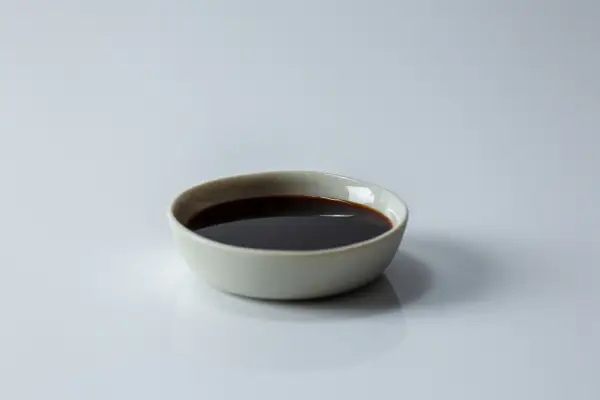Acceda a la base de datos First Foods® en Solid Starts App.
Leer másSoy Sauce
Condimento
Sugerencia de edades
6 meses
Alto contenido de hierro
No
Alérgeno común
Sí

When can babies have soy sauce?
Dishes that contain soy sauce as an ingredient may be introduced as soon as baby is ready to start solids, which is generally around 6 months of age. While soy sauce is high in sodium, a taste here and there of a dish containing soy sauce is fine as part of a varied diet. Note that soy sauce contains common allergens, including soy and often wheat.
While there are many types of soy sauce, widely available styles are based in ancient East Asian culinary practices. Traditionally, soybeans and wheat are cooked, then mashed together along with a particular strain of mold. This process kickstarts fermentation, which produces glutamic acid, the source of that rich, umami flavor also found in broths, mushrooms, and other foods. From there, salt, water, and a yeast mixture are added, and after further aging, the resulting liquid is strained and pasteurized.
How do you serve soy sauce to babies?
Cada bebé se desarrolla a su propio ritmo, y las sugerencias que ofrecemos sobre cómo cortar o preparar determinados alimentos son generalizaciones para una amplia audiencia.
6 months old +:
If you happen to have a dish that contains some soy sauce already prepared for yourself and you’d like to share a taste here and there with baby, feel free to do so. While soy sauce is high in sodium, sharing a small amount of an age-appropriate dish is completely fine.
12 months old +:
Use soy sauce as you normally would in family meals, as a marinade, as a seasoning in sauces, stews, or stir-fries, or as part of a sauce in meals, as desired.
24 months old +:
Continue serving age-appropriate foods and dishes with soy sauce as desired. At this age, you can also offer a small amount of soy sauce in a cup or bowl and model how to dip, then let the toddler try. Or, show how to drizzle soy sauce onto food.
Videos
Is soy sauce a choking hazard for babies?
No. Soy sauce presents a low risk when safely prepared for a child’s age and developmental ability, though, in theory, an individual could choke on any food. To reduce the risk, prepare and serve soy sauce in an age-appropriate way as described in the How to Serve section. As always, make sure you create a safe eating environment and stay within an arm’s reach of baby during meals.
Learn the signs of choking and gagging and more about choking first aid in our free guides, Infant Rescue and Toddler Rescue.
Does soy sauce contain common allergens?
Yes. Soy sauce is made from soy and often contains wheat, both of which are common food allergens. That said, some individuals with allergies to soy protein or wheat are able to tolerate soy sauce in moderation. If baby has a known allergy to soy or wheat, discuss with your allergy specialist before introducing soy sauce.
If a child is allergic to wheat, but tolerates soy, they may be able to safely consume a wheat-free soy sauce, such as tamari. Be sure to read labels carefully to ensure that the child’s allergen is not on the ingredient list.
Prior to sharing soy sauce with a child, it is important to introduce soy and wheat (and any other common allergens in the sauce) and rule them out as an allergy. This way, when you are ready to offer soy sauce, you will be confident that the child has already safely eaten soy, wheat, and any other common food allergens in the sauce. This approach will also help you identify which food is responsible if the child has an allergic reaction when eating a dish that contains soy sauce combined with other ingredients.
As you would when introducing any new food, start by offering a small quantity for the first few servings. If there is no adverse reaction, gradually increase the quantity over future meals.
What are the benefits of sharing foods that contain soy sauce with babies?
While soy sauce is not usually eaten in nutritionally significant amounts, it does offer small amounts of carbohydrates, amino acids, acids, and antioxidants, as well as prebiotics to support baby’s flourishing gut microbiome.
While soy sauce is high in sodium, the amount of sodium that babies eat tends to be low as they learn the skills to feed themselves. Some sodium is important for supporting baby’s electrolyte balance, hydration, and movement. While many health organizations recommend holding or reducing salt in food shared with baby, recent reviews of literature suggest that this may not be necessary. Furthermore, sharing family meals, even if they contain salt, has its benefits: baby has opportunities to explore a wider variety of food, share their family food culture, and practice eating a variety of textures.
If you would like to reduce sodium levels in a family meal, you can consider:
Using a low-sodium soy sauce.
Using less soy sauce than the recipe suggests.
Adding soy sauce only to the adults’ portions of the meal, not to the whole meal as it cooks
Incorporating other ingredients like mushrooms, garlic, ginger, green onions, seaweed, dashi to boost a dish’s umami flavor without additional sodium.
Diluting soy sauce with water or rice vinegar.
Nuestro equipo
Escrito por
Consejos de expertos directo a tu bandeja de entrada
¡Suscríbete y recibe correos semanales con recetas, consejos y más!
Copyright © 2025 • Solid Starts Inc






